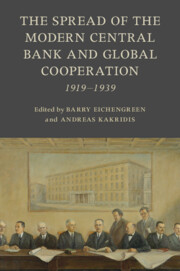Book contents
- The Spread of the Modern Central Bank and Global Cooperation
- Studies in Macroeconomic History
- The Spread of the Modern Central Bank and Global Cooperation
- Copyright page
- Contents
- Figures
- Tables
- Editors and Contributors
- Preface
- Part I General
- Part II Specific
- 5 Central Bank Policy under Foreign Control
- 6 Sneaking Nationalization
- 7 The Bank of Poland and Monetary Policy during the Interwar Period
- 8 From Banking Office to National Bank
- 9 ‘Nobody’s Child’
- 10 The Bulgarian National Bank, 1926–1935
- 11 Macroeconomic Policies and the New Central Bank in Turkey, 1929–1939
- 12 Latin American Experiments in Central Banking at the Onset of the Great Depression
- 13 Central Banks in the British Dominions in the Interwar Period
- 14 Central Banking and Colonial Control
- Index
- References
14 - Central Banking and Colonial Control
India, 1914–1939
from Part II - Specific
Published online by Cambridge University Press: 02 November 2023
- The Spread of the Modern Central Bank and Global Cooperation
- Studies in Macroeconomic History
- The Spread of the Modern Central Bank and Global Cooperation
- Copyright page
- Contents
- Figures
- Tables
- Editors and Contributors
- Preface
- Part I General
- Part II Specific
- 5 Central Bank Policy under Foreign Control
- 6 Sneaking Nationalization
- 7 The Bank of Poland and Monetary Policy during the Interwar Period
- 8 From Banking Office to National Bank
- 9 ‘Nobody’s Child’
- 10 The Bulgarian National Bank, 1926–1935
- 11 Macroeconomic Policies and the New Central Bank in Turkey, 1929–1939
- 12 Latin American Experiments in Central Banking at the Onset of the Great Depression
- 13 Central Banks in the British Dominions in the Interwar Period
- 14 Central Banking and Colonial Control
- Index
- References
Summary
In the 1920s, the Bank of England promoted central banking to preserve London’s control over Indian financial policies and insulate those policies from political changes sweeping the colony. This chapter traces India’s deepening distrust of London in the monetary sphere, and the role envisaged by the Bank of England for an Indian central bank operating under its tutelage. After the failure of efforts to create a central bank in the 1920s, the Bank of England and Whitehall insisted on a privately owned, ‘independent’ central bank as a precondition for Indian constitutional reform. In the end, notions of an independent central bank did not stand up to the vicissitudes of colonial bureaucratic politics. Efforts of the colonial government and the Bank of England to curb the independence of the Reserve Bank of India offer important insights into the early history of central banking in India, but also shed new light on the role central banks in economies undergoing the transition from colonialism to independence.
Keywords
- Type
- Chapter
- Information
- The Spread of the Modern Central Bank and Global Cooperation1919–1939, pp. 383 - 405Publisher: Cambridge University PressPrint publication year: 2023

